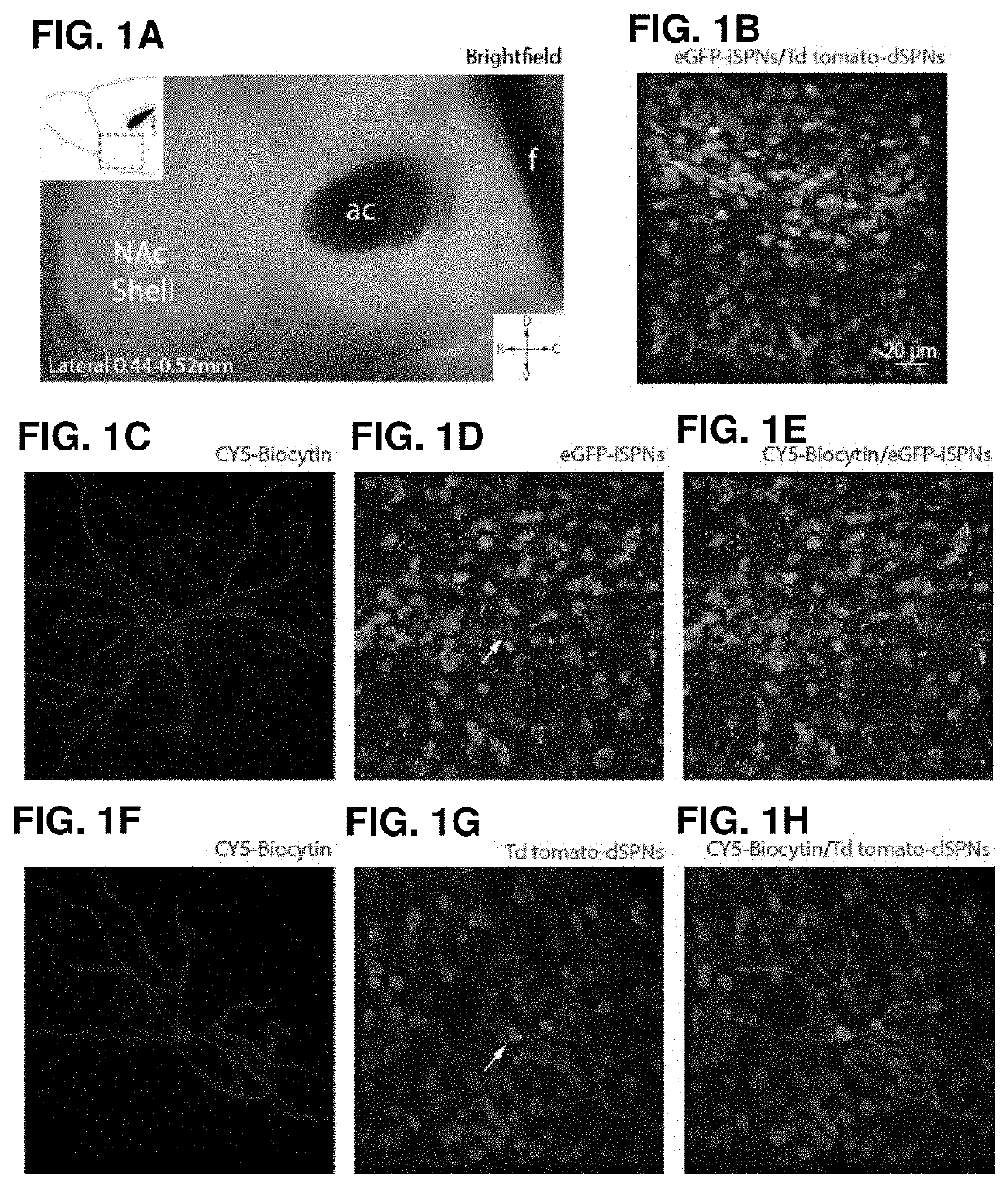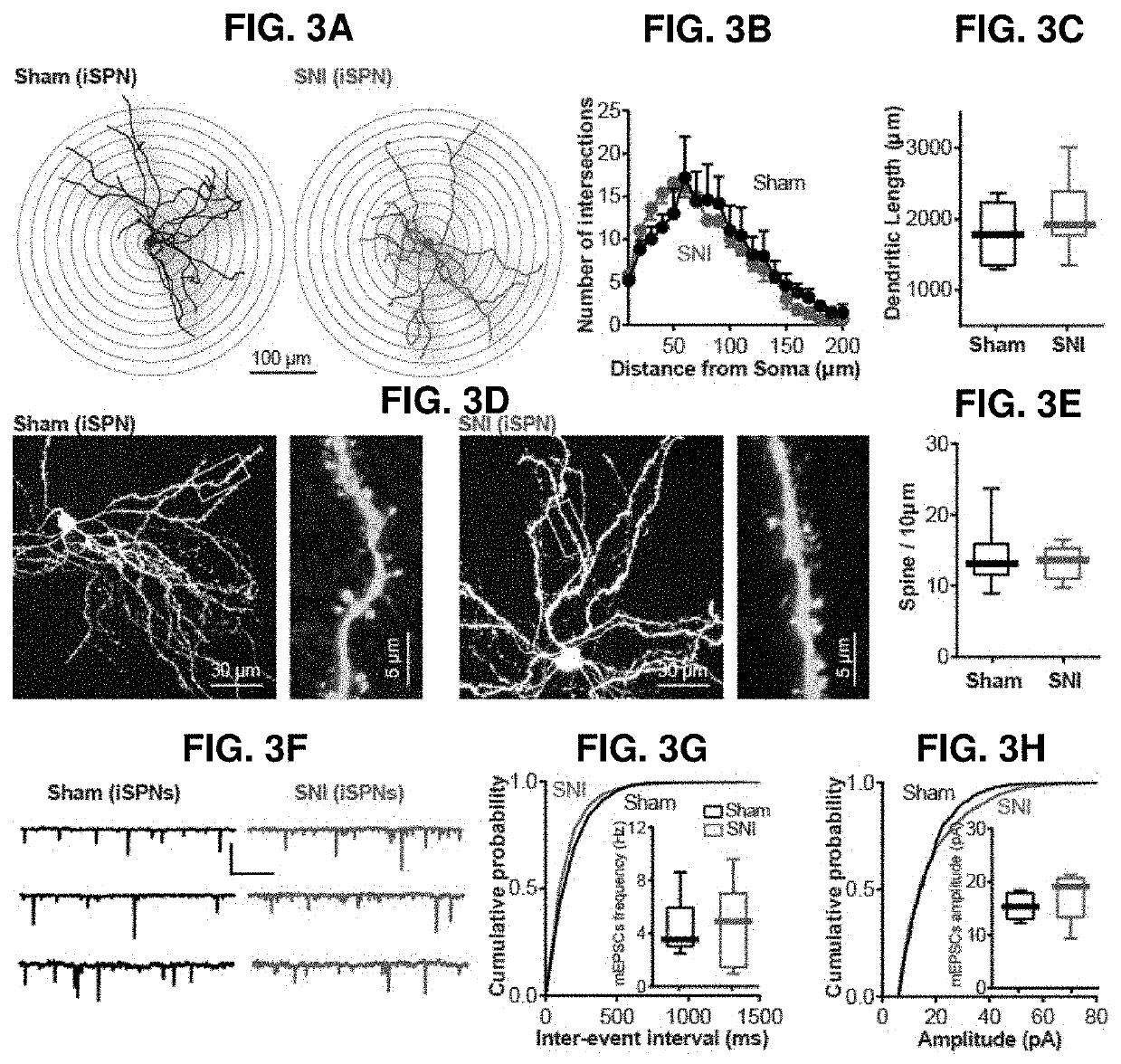Methods and compositions for treating pain
a technology of compositions and pain, applied in the field of methods and compositions for treating pain, can solve the problems of increasing the cost of chronic pain in the united states, creating unpleasant sensory and emotional experiences, and limited efficacy of nsaids in most cases of chronic pain, so as to reduce the likelihood of recurrence, reduce the severity of the disease, and inhibit the progression
- Summary
- Abstract
- Description
- Claims
- Application Information
AI Technical Summary
Benefits of technology
Problems solved by technology
Method used
Image
Examples
example 1
or Testing the Efficacy of Compositions for Treating and Preventing Pain
[0123]Forebrain limbic circuitry has been implicated in the expression of chronic pain (Raz, 2009, Perspectives in biology and medicine 52, 555-565). The nucleus accumbens (NAc) is a key component of this circuitry (Bromberg et al, 2010, Neuron 68, 815-834). Human studies suggest that neurons in the NAc encode pain salience and value for pain relief, and the strength of its functional connectivity with the medial prefrontal cortex is predictive of the transition to chronic pain (Baliki et al, 2010, Neuron 66, 149-160). Animal studies of persistent pain also have implicated the NAc. Infusion of dopaminergic agonists into the NAc ameliorates the tactile allodynia in a rodent neuropathic pain model (Sarkis et al, 2011, Eqp. Neurol. 228, 19-29). The NAc shell also appears to be important in signaling value for pain relief (Baliki et al, 2013, The Journal of Neuroscience 33, 16383-93). Given the well-established link...
example 2
l Neuropathic Injury Selectively Increased ISPNs Excitability
[0147]Because NAc dSPNs and iSPNs are differentially linked to behavioral activation, which is clearly altered in chronic pain states (Alba et al, 2013, Biological Psychiatry 73, 54-62), it was important to distinguish between them in our assays. To do so, our studies took advantage of transgenic mice in which dSPNs and iSPNs expressed red and green fluorescent proteins, respectively (FIG. 4A and FIG. 1B). These transgenic mice did not differ from wild-type in their response to SNI (FIGS. 2A-2B). To minimize experimental variability, one dSPN and one iSPN were sampled from the same brain slice (FIGS. 4B-4C and FIGS. 1C-1H). Five days after the SNI (or sham) surgery, mice were tested for tactile allodynia and sacrificed to obtain sagittal brain slices containing the ipsilateral and contralateral NAc. SPNs in the NAc shell were visually identified by their fluorescence and then whole cell patch clamp recordings were made. In...
example 3
ed Shortening of ISPNs Dendrites
[0148]To determine if there were morphological changes accompanying the elevation in intrinsic excitability, iSPNs of the NAc shell were filled with biocytin and then reconstructed. This analysis revealed profound changes in iSPNs dendrites following SNI (FIG. 5). To quantify these changes, dendritic trees were subjected to a Sholl branching analysis and to dendritic path length measurements. The Sholl branching analysis revealed that iSPN dendrites from SNI mice had reduced branching than sham (FIGS. 5A, 5B). Moreover, total dendritic length was reduced (FIG. 5C). In contrast, neighboring dSPNs dendrites were unaffected (FIGS. 3A-3E). Although dendritic branching and length were reduced in iSPNs following SNI, spine density was unchanged (FIGS. 5D-E). Nevertheless, the reduction in dendritic length should lead to a reduction in the total number of excitatory glutamatergic synapses. To test this prediction, glutamatergic miniature excitatory post-syna...
PUM
| Property | Measurement | Unit |
|---|---|---|
| time | aaaaa | aaaaa |
| time | aaaaa | aaaaa |
| time | aaaaa | aaaaa |
Abstract
Description
Claims
Application Information
 Login to View More
Login to View More - R&D
- Intellectual Property
- Life Sciences
- Materials
- Tech Scout
- Unparalleled Data Quality
- Higher Quality Content
- 60% Fewer Hallucinations
Browse by: Latest US Patents, China's latest patents, Technical Efficacy Thesaurus, Application Domain, Technology Topic, Popular Technical Reports.
© 2025 PatSnap. All rights reserved.Legal|Privacy policy|Modern Slavery Act Transparency Statement|Sitemap|About US| Contact US: help@patsnap.com



